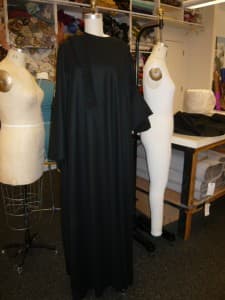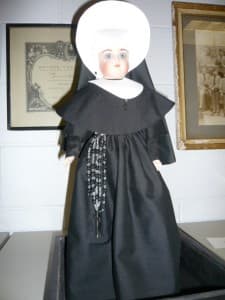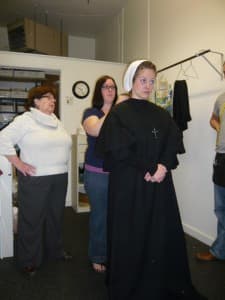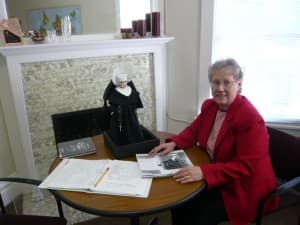The Complexities of the Nun’s Habit – Suor Angelica Costumes
by Sue Allred
I find each opera brings new challenges and learning, and Suor Angelica has been no different. This opera has been “updated” and is now placed in about 1947, so it must have a very different look from the traditional period most people expect to see. We have basically three colors on stage for this entire opera. Those colors are black, white, and tones of gray. It is actually appropriate for the characters of course, but also the text of the play. We associate black and white with sin and gray as the space in between. The color white is also associated with purity and often with sacrifice.
Our nuns are designed after our “Sisters of the Holy Cross”. The Catholic Diocese of Salt Lake has been so helpful with research and information. They have provided photos and private interviews to help with the visuals for the Nun’s habits or robes. It has been so interesting to learn that they actually used straight pins to hold most of their habit together. Sleeves were pinned up for cleaning and turned down for prayer. The habit is no longer worn but it still has symbolism and importance. I have great admiration for the service and dedication it takes to become a nun.
In our opera our Sister Angelica did not become a nun by choice but has made the best of her situation, which is a good life lesson. The habits are made of soft wool and works well under stage lighting, which is also something a designer has to think about. We have the Princess who is the opposite of kindness and humility. She is dressed in a “stern” gray wool suit with everything looking perfect….except her behavior toward Angelica. The young child in the opera is in pure white depicting perhaps purity and sacrifice. We find a miracle in the opera as the statue opens her arms perhaps forgiving Angelica as she presents her young son to her. The music of this opera helps us visualize the order and peace the Nunnery provides for all…except our Sister Angelica.
Special thanks go to archivist Gary Topping, Sister Genevra Rolf, and Sister Catherine Kamphaus for being so generous in sharing their knowledge and experience!






